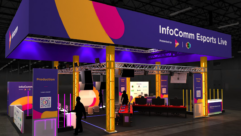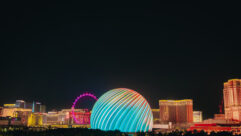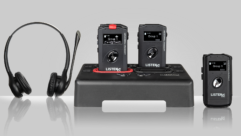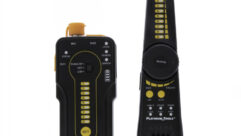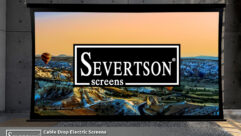INFOCOMM ’01 Wrap-Up
Aug 1, 2001 12:00 PM,
BY PETER H. PUTMAN, CTS
IT WAS INEVITABLE THAT INFOCOMM, THE INDUSTRY’S PRE-EMINENT A/V show, would wind up in Las Vegas, the glitz capital of the world. The overwhelming number of electronic display technologies seen at INFOCOMM fit naturally with the video-in-your-face atmosphere all over the city.
Trade show floor space expanded to a new high of 513 exhibitors occupying nearly 300,000 square feet inside the Sands Expo Center. The serendipitous contiguity of the Venetian and Sands show floors made it convenient to dash from booth appointments to classes and back to the floor.
MAIN THEMES: AGGRESSIVE PRICING & LINE EXPANSION
There wasn’t much technological breakthrough this year; rather, the show reflected the vagaries of the national economy aggressive product pricing and line expansion were the hot topics. The cutthroat discounting started by Sony in 1999 with the VPL-CS1 LCD projector is still affecting the industry. Sony’s lowball move in fall 2000, with its 42-inch PFM-42B1 plasma, caused several companies to drop 50-inch panel prices into the $17-18K range earlier this year. But Panasonic pulled the trump by introducing its 50-inch TH-50PHD3U at the show with a $13,995 MSRP. (Now NEC knows what to charge for its new 61-inch plasma panel the old 50-inch price!) Predictions were made at NAB 2001 that we might see 50-inch panels under $10,000 by the end of this year, and that’s looking like an even stronger bet right now.
Extron Electronics had one of the broadest lines of new products, including a media control system that seems to tread into Crestron and AMX territory (though Extron denies this). Speaking of AMX, they’re back, having consigned the Panja name to history. Upstart Kramer Electronics, with its strong management team, vied for a piece of Extron’s (and Folsom’s) business with low-priced interfaces and seamless video/RGB scaler/switchers.
Clarity, Synelec, Mitsubishi and ImTech are burying the term videowall in favor of datawall, having found a rich new niche market in financial and public displays. NEC, Epson, Sony, Barco, Mitsubishi and others showed IP-enabled projectors and/or plasma monitors, reflecting the increasing interest in blending LANs into the A/V world.
JVC surprised everyone by showing a new and improved QXGA D-ILA projector (yes, that’s 2048 by 1536 true pixels, unlike the Lasergraphics enhanced-XGA LCD projector); but Hitachi, Philips, Sanyo, 3M, Samsung and InFocus also got into the LCoS act. There’s big money in reflective liquid crystal for high-resolution imaging, so look for more companies to get into this game shortly.
The other big news was the proliferation of ultra-micro DLP projectors, led by Plus with its new sub-2-pound design. As I said to TI officials, it’s now possible to lose both the remote and the projector behind your couch! Similar mockups and prototypes were seen from InFocus, Sharp, Mitsubishi, Philips, Acer, Compaq and others in the TI DLP booth. These products will also be aggressively priced and will inevitably show up at computer and office supply discounters.
SO WHAT HAPPENED AT THE O.K. CORRAL?
Last year, I dropped my annual analysis of the Projection Shoot-Out due to the withdrawal of Sony and Christie and a sub-par staging in Anaheim. I made an observation (which proved to be rather controversial) that the event appeared to be wobbling on its last legs.
Well, if this year was any indication, that observation was not far off the mark. Following Sony’s and Christie’s lead, several other manufacturers skipped the Shoot-Out entirely to concentrate on booth space instead. The Shoot-Out hall was noticeably smaller this year, with 84 entries dominated by the likes of Sanyo, Mitsubishi, Panasonic, Sharp, Viewsonic and Hitachi.
At least one of this year’s participants told me they wouldn’t be back for 2002 since the absence of virtually all the market leaders rendered the competition virtually meaningless. Buyers now look for the lowest price in a given brightness/resolution category, not the best-looking or brightest image.
Two of this year’s Shoot-Out categories featured exactly one entry each, while seven had all of two entries apiece. The largest category in 2000 (1024×768 desktop projectors) featured 27 entries; this year, the largest category featured 15. However, there was a bright spot: The test images featured pop-up word balloons that instructed a viewer where and what to look for in a given test image, which was a great idea on the part of the Shoot-Out committee led by Steve Somers of Extron.
What about next year? There was talk of merging the Shoot-Out with the Display Systems Encounter. This might be a good idea, given the increased emphasis on education at INFOCOMM and the reluctance on the part of exhibitors to spend extra money outside of their booth space. The feeling is that INFOCOMM is a strong, unique trade show, well able to survive without the Shoot-Out, if it comes to that. The record number of seminars, increased booth-space sales and the general positive buzz are ample proof of this.
THE SHOW IN A (LARGE) NUTSHELL
After 30 pounds of literature and hours of note-taking, I’ve prepared a distilled version of the show. It was impossible to visit everyone; so apologies to those I missed. The products I found particularly noteworthy or significant, however, are identified in the box at left.
PROJECTORS: A MOTHER LODE
Projectors make the show go, and this year INFOCOMM featured a dizzying number of new ones.
InFocus revealed a line of microportables, desktops and installation designs. For INFOCOMM, the company announced the LP290, an ASK-designed, 5.7-pound desktop, XGA (1024 by 768) LCD projector. It’s got a nice European look and develops 1100 ANSI lumens. More importantly, it has a suggested MSRP of $3999.
InFocus also unveiled the LP530, another 5.7-pound projector that uses DLP technology. It also features XGA resolution but is one of the first single-chip DLP projectors to break the 2000-lumens barrier. Variable brightness settings for economy, video signal processing by Sage (Faroudja) and a suggested price of $4999 round out the picture. For installations, InFocus offers the Proxima Pro AV 9410, a 1280×1024 box with interchangeable lenses rated at 3700 ANSI lumens and 600:1 contrast.
JVC‘s demo of the DLA-QX1 consistently brought in big crowds. The model on display was rated at 7000 ANSI lumens and greater than 1000:1 contrast. And although it still had a few image artifacts, it looked substantially improved from its debut at ShoWest. The DLA-M5000L and DLA-M5000SC large-venue D-ILA projectors were also out for viewing. Both feature 1365×1024 native resolution and are rated at 5000 ANSI lumens.
For the portable and desktop market, JVC also showed the DLA-DS1, an updated version of the DLA-3010Z prototype. This 14.3 chassis has SXGA resolution and is rated at 1300 ANSI lumens, making it the smallest (so far) and least-expensive (at $8995) SXGA projector on the market. For the home theater and cinema crowd, JVC demonstrated the DLA-G150HT CineLine projector, using a proprietary Video Gamma Profile grayscale tracking system to maintain true D-6500 color balance, rated at 1000 ANSI lumens.
Panasonic had a striking demo of its near-DLP-Cinema projector design, the PT-D9610U. Although Panasonic is not one of the three official DLP Cinema licensees, it has tinkered with the optical path, mirrors, and extra apertures to lower black levels and boost contrast. I had to admit the results were quite impressive for a “standard” large-venue DLP chassis. (When asked, some TI representatives said they encouraged all of their customers’ efforts to advance DLP imaging, but at least one person at TI “wasn’t too thrilled” with Panasonic’s efforts to blur the standard DLP and DLP-Cinema boundary.)
Panasonic also had the PT-L711XNTU ultra-portable on display, using a wireless interface to communicate with a nearby 802.11b-equipped notebook computer. Two new portable LCD projectors entered the line: the XGA-resolution PT-L759XU (3100 lumens) and PT-L759VU (2400 lumens). Panasonic’s ultra-portable line has expanded by five models, ranging from the PT-L711XU (XGA, 1600 lumens) to the PT-L501XU (SVGA, 1200 lumens).
Christie Digital announced the sale of the DigiPro DLP Cinema projector to Industrial Light and Magic just before the show, which gave the company some nice momentum. At the Christie booth, the Vivid Red LCoS front projector was in the spotlight. This model uses three 0.9-inch D-ILA panels (yes, they’re from JVC) and features SXGA (1365 by 1024) native resolution. It’s rated at 1800 ANSI lumens and 500:1 contrast.
Enhancements were also announced to existing Christie models. The Roadster X4/S4 and Roadster X6/S6 modular DLP projectors got a boost to 4000 and 6000 lumens respectively, and feature new stacking and rigging systems. A partnership was announced with 3D Perception to use CompactU technology inside Christie projectors for simulation and 3D curved screen projection. (It works, but you still need those special glasses.)
Mitsubishi promoted the heck out of its sRGB-compliant projectors, showing off the new X500 desktop/installation projector (16 pounds, 3700 lumens, XGA), the 1024×768 X490 and 800×600 S490 (each at 2500 lumens, 16 pounds), and the super-small XL1 and SL1 compact LCD projectors (1000 lumens, 6.5 pounds). Mitsubishi also had a demo of the Mini-Mits microportable DLP projector, and it’s reasonable to assume that an even smaller version will follow soon.
NEC Technologies brought plenty of new products along. Its MultiSync GT950 desktop/installation projector has true (not digital) dual-axis keystone correction, a must for stacking and seamless image projection. This 15-pound projector uses XGA LCD technology and can be fitted with an optional LAN card. NEC’s GT2150 now occupies the top spot in NEC’s LCD category, delivering 1365×1024 resolution, 3:2 pulldown compensation, DVI input and interchangeable lenses.
Upgrades to the LT series were also on view, with the LT75 (SVGA) and LT150z (XGA) both delivering 1000 ANSI lumens and a claimed 800:1 contrast. Each projector has a built-in flashcard reader for notebook-less presentations, as well as NEC’s Vortex image enhancement technology. Across the aisle, some new additions to the Nighthawk line were showcased. The SX10000 is an 8000-lumen, SXGA (1280 by 1024) DLP large-venue chassis; while the XT4100 (XGA) and S4100 (SXGA) are more compact 3-chip DLP designs for small to mid-sized installs. Both are rated at 3500 ANSI lumens brightness.
Epson has been doing its homework and announced a trio of portable projectors at the show. The PowerLite 810p is a 2000-lumen XGA chassis that weighs 9.3 pounds. The PowerLite 800p is identical except it gets 1500 lumens. For SVGA fans including the budget-conscious educational market the PowerLite 600p presents 1700 lumens in a 9.3-pound package. All three models support the sRGB color standard. For the installation crowd, the PowerLite 8150i cranks out 3200 lumens in a 20-pound box and provides LAN connectivity, wired and wireless, through Epson’s EasyMP.net software.
Sanyo retired its Projector Hall of Fame booth and went with a more contemporary presentation, showcasing the largest line of LCD projectors in the industry. Attention focused on the PLC-UF10, the only true UXGA (1600×1200) LCD projector available on the market. This 78-pound chassis is rated at 7700 ANSI lumens and offers a range of interchangeable lenses.
Two new large-venue models made a splash: the 5800-lumen PLC-EF30/L (1280 by 1024, dual lamps, DVI) and the 5200-lumen PLC-XF30/L (1024 by 768, dual lamps, DVI). There was a new portable PLC-XP45/L (3500 lumens, XGA); three 8.6-pound ultra-portables PLC-SU30, PLC-XU30, and PLC-XU35 ranging from 1600 to 2000 ANSI lumens; two microportables PLC-XW20 (XGA, 1100 lumens) and PLC-SW15 (SVGA, 700 lumens); and the PLV-60HT home theater projector (1366×768 wide XGA, 1200 lumens). If that weren’t enough, there was even a LCoS prototype desktop projector on display.
Sony had the second-largest booth at the show, and the emphasis was on LAN connectivity and IP addressing. Even so, a few new projectors popped up, led by the VPL-PX15, a network-ready desktop/installation model with 1024×768 resolution and a rating of 2000 ANSI lumens. The VPL-PX10 also has XGA resolution and is rated at 2000 ANSI lumens but is not a network design. To complement the PX10 is the SVGA-resolution VPL-PS10, which delivers 1500 ANSI lumens.
Across the way, three new 5.5-pound microportables with 0.7-inch LCD panels grabbed some attention. The VPL-CX3 uses Sony’s Memory Stick technology for PC-less presentations and is rated at 900 ANSI lumens using 1024×768 LCDs. A lower-brightness version, VPL-CX2, is rated at 750 ANSI lumens, while the SVGA (800×600) VPL-CS3 cranks out 700 ANSI lumens. All three models have a unique flip-up top control panel with built-in speakers. For the installation crowd, the super-bright quad-lamped VPL-FE110U (4000 lumens, SXGA) and cool-looking VPL-FX50U (3500 lumens, XGA) were quite popular. Both are network-capable.
Barco unveiled a new network projector series: the 6400i. The BarcoGraphics 6400i features 1024×768 LCD panels and a new 600-watt UHP-style lamp, while the BarcoReality 6400i uses the same lamp and 1280×1024 LCD panels. Both are rated at 3200 ANSI lumens, and both can be set with IP addresses on a local-area network.
Barco also showed the newly announced BarcoReality 6500DLC, first seen at NAB 2001. This small, large-venue projector is capable of 5500 ANSI lumens and uses micro-lens array 1280×1024 LCD panels for SXGA display, plus Barco’s Pixel Map Processor to scale lower- and higher-resolution sources. There’s also an optional IEEE-1394 input for direct digital connection to D-VCRs and digital cameras.
Sharp featured the ultra-small Notevision M15X (1024×768 DLP) and Notevision M15S (800×600 DLP). Both projectors weigh just 3.5 pounds and are rated at 1100 ANSI lumens. Each supports analog and DVI signals. The Notevision C20 compact LCD projector is an XGA LCD design and isn’t much bigger than the 15-series at 5.5 pounds. It cranks out 1000 ANSI lumens. Also on display were the Notevision M10S and M10X DLP micros, both at 2.9 pounds, 800 lumens.
For the install market, Sharp showed the XG-V10XU and XG-V10WU. The V10W is rated at 4700 ANSI lumens, the V10X at 4000. Both use 3-panel LCD technology, with XGA (1024×768) panels inside the V10X and SXGA (1280 by 1024) panels in the V10W. A range of interchangeable lenses is offered for both models. In the hang-and-bang (fixed installation) category, there was the XG-P20XU (3300 ANSI) and XG-P10XU (3000 ANSI). Both weigh in at less than 21 pounds, and the P20XU uses Gyration Inc.’s GyroPoint RF mouse technology.
Digital Projection, despite the battered stock price of parent company Imax, made a nice showing in Las Vegas. Its 20-Series Lightning displays really push the illumination bar past 12,000 lumens. The Lightning 22gv is rated at 10,000 ANSI and uses XGA (1024 by 768) native resolution DMDs, plus Faroudja/Sage and Cintel digital signal processing. One step up is the Lightning 22sx, with 11,000 ANSI lumens and SXGA (1280 by 1024) native resolution, also with the Faroudja/Cintel combo. Finally, there’s the Lightning 25sx, rated at a mind-boggling 14,000 lumens with SXGA resolution and Faroudja/Cintel inputs. All models support wide-bandwidth SDI.
Plus had some projectors that are smaller than the DP remotes! The newest entries and those that got the most attention were the 2-pound V-1080SF (XGA, 0.7-inch DMD, 800 lumens) and V-807SF (SVGA, 0.7-inch DMD, 700 lumens). Both projectors measure but 1.8 inches thick. I’m not kidding, you really can lose one of these beneath the couch cushions! Plus also had a clever-looking home theater projector, the HE-3100, which is the first to use the recently announced 16:9, 848×480 SDTV DMDs. It incorporates a quiet 33dB fan and automatic 3:2 pulldown compensation. And, it’s a light 4.4 pounds.
Hitachi has expanded on its microportable LCD line with the CP-X270W. This 800-lumen, XGA design is 2.4 inches thick and weighs 5 pounds. It was accompanied by two new portable/desktop models, the CP-X980W (2300 lumens) and CP-X985W (2700 lumens). Both projectors incorporate progressive-scan technology and use XGA (1024 by 768) LCD panels. Around the corner, Hitachi had a demo of its first LCoS projector, the CP-SX5500W. This SXGA (1365 by 1024) design is rated at 1500 lumens, but like the JVC DLA-DS1 is priced competitively at $8995. (I suspect it uses JVC devices as well.)
Toshiba continues to upgrade its line. This year, it brought out two new portable XGA projectors (TLP-780/781), both XGA LCD designs rated at 2000 lumens. (The XX1 version has the attached video document camera.) The TLP-680/681 designs weigh under 10 pounds and develop 1500 ANSI lumens, while the TLP-550 and TLP-250 are more affordable XGA and SVGA models.
Toshiba also jumped into the home theater market with the TLP-MT7, a widescreen LCD projector with 1280×720-pixel LCD panels and a rating of 1000 ANSI lumens. For fixed installs, there’s the TLP-X20. It has a DVI interface, a PCMCIA memory card slot, XGA (1024 by 768) resolution, and is rated at 2400 ANSI lumens.
You can see where things are headed: Leading manufacturers are getting into as many lines as possible while simultaneously reducing prices to get into more consumer homes. These advances are underscored by small but significant steps in improving the capabilities of these technologies. We’ll see similar trends when this wrap-up continues next issue with plasma display panels and datawalls.
Peter H. Putman owns PHP Communications, Doylestown, Pennsylvania. He has been reviewing INFOCOMM’s Projection Shoot-Out annually since 1994 and continues to write about video displays and computer/video interfaces.
BEST IN SHOW
Significant technological advances or overall product excellence distinguishes these projectors.
InFocus LP530
Among the first single-chip DLP projectors to break the 2000-lumens barrier
Hitachi CP-SX5500W
A competitively priced LCoS projector rated at 1500 lumens
JVC DLA-QX1
7000 ANSI lumens and greater than 1000:1 contrast impressive despite a few remaining artifacts
JVC DLA-DS1
So far the smallest and least expensive SXGA projector on the market
NEC Technologies MultiSync GT950
True dual-axis keystone correction, a must for stacking and seamless projection
Panasonic PT-D961OU
A “near-DLP-Cinema” projector with impressive quality for standard DLP
Plus V-1080SF and V-807SF
Tiny, 2-pound projectors could get lost behind cushions if you’re not careful
Plus HE-3100
A 4.4-pound home theater projector using 16:9, 840×480 SDTV DMDs
Sanyo PLC-UF10
The only true UXGA LCD projector on the market
Toshiba TLP-MT7
A widescreen LCD projector for the home theater market
Vital Stats
Venue wasn’t the only change this year. 2001 also saw new leadership from ICIA, a new logo for INFOCOMM and a record number of educational seminars.
Number of Exhibitors: 513
Exhibit Space: 300,000 square feet
Registered Attendees: 22,460
Educational Registrants: 5,937
First Keynote Attendance: 251
Second Keynote Attendance: 268
Third Keynote Attendance: 299
Next Year’s Show: June 12-14, Sands Expo and Convention Center, Las Vegas


